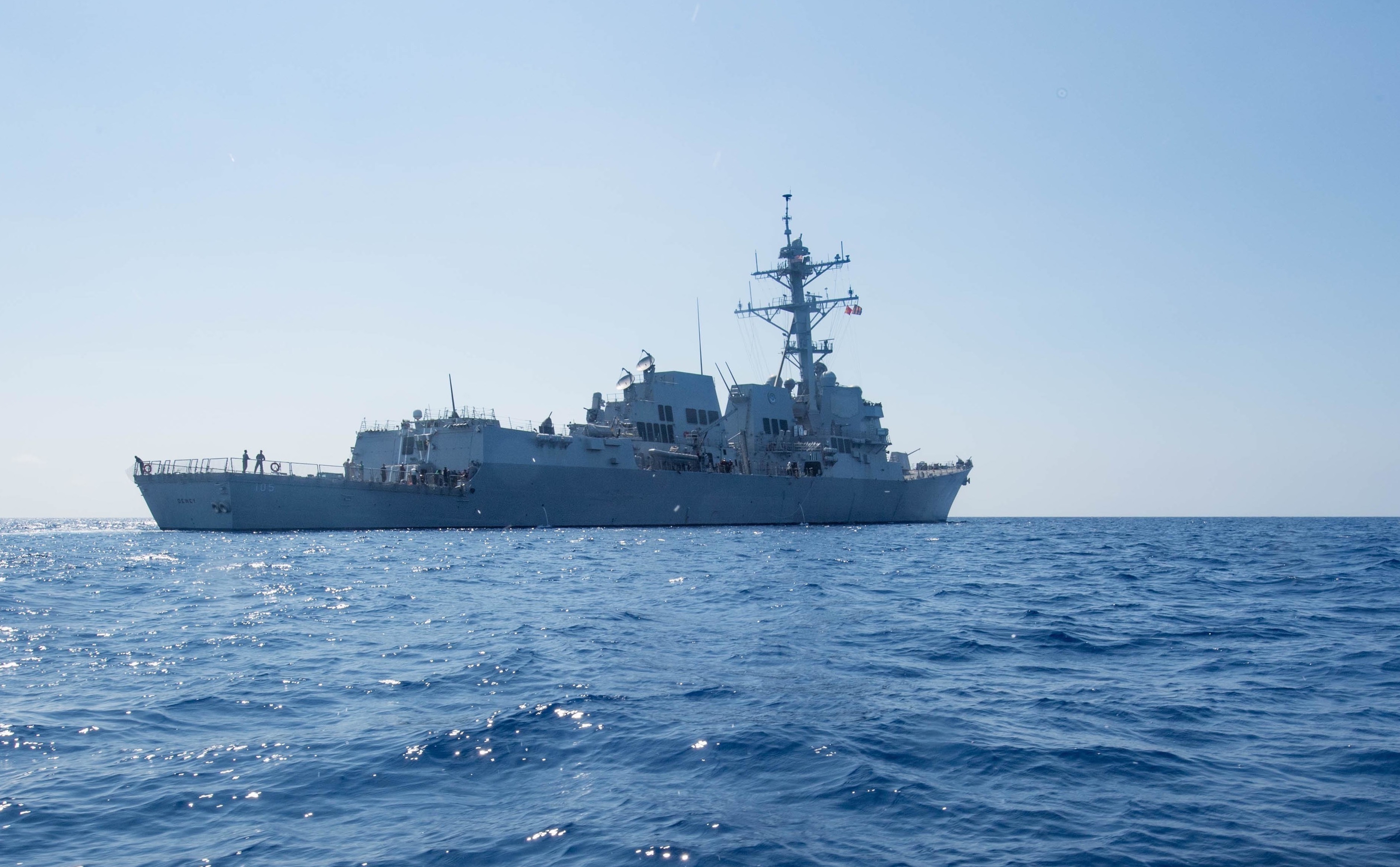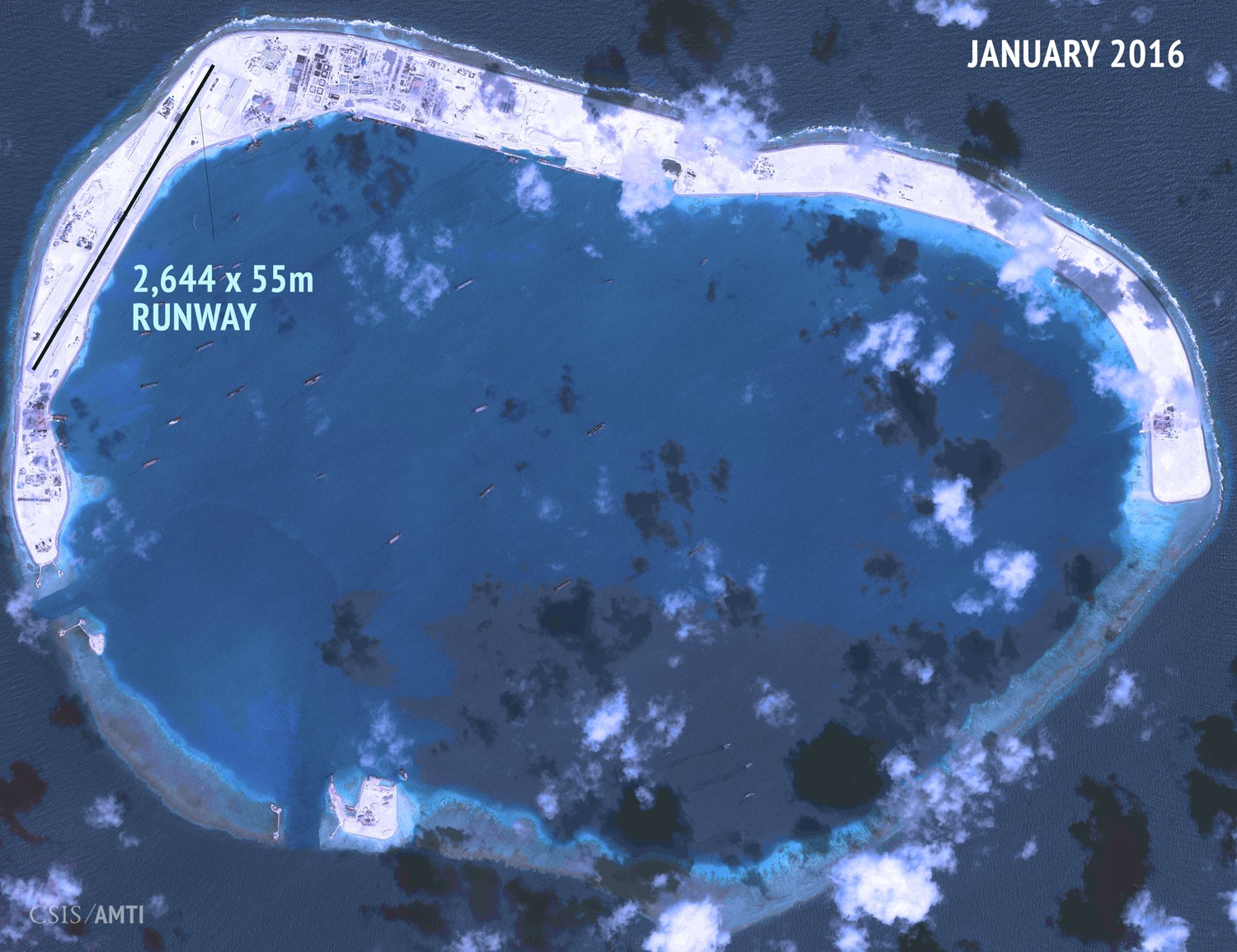
This post has been updated with additional information on the Dewey freedom of navigation operation.
A U.S. destroyer sailed within six nautical miles of a Chinese artificial island on Wednesday in the strongest challenge of hotly debated Chinese claims in the South China Sea, USNI News has learned.
Around 7 P.M. EST on Wednesday (7 A.M. Thursday local time), USS Dewey (DDG-105) passed within six nautical miles of the Chinese installation on Mischief Reef in the Spratly Island chain, several U.S. officials confirmed to USNI News
The guided-missile destroyer operated normally and did not conduct the transit under the rules of an innocent passage – the restrictions that allow a warship to pass through another country’s territorial waters with no notice.
The ship was within 12 nautical miles of Mischief Reef for about 90 minutes zig-zagging in the water near the installation. At one point during the operation, the ship’s crew conducted a man overboard drill, a U.S. official told USNI News.
The U.S. destroyer was shadowed by a Chinese frigate for the duration of the operation and was challenged by radio and warned to leave the vicinity by People’s Liberation Army units more than 20 times, USNI News has learned.
A PLA spokesperson told reporters on Thursday two PLA Navy frigates had “warned off” Dewey.
The operation is the first freedom of navigation operation (FON op) to challenge Chinese South China Sea claims during the Trump administration and the first in the region since USS Decatur (DDG-73) conducted a FON op against excessive Chinese claims in the Paracel Islands in October.

Pentagon spokesman Capt. Jeff Davis would not confirm the U.S. had conducted the specific freedom of navigation operation when asked by USNI News on Thursday morning.
“We are continuing regular FON ops, as we have routinely done in the past and will continue to do in the future,” Davis told USNI News.
“Summaries of these operations will be released publicly in the annual FON ops report, and not sooner.”
However, Chinese officials quickly confirmed and condemned Dewey’s passage past Mischief Reef early Thursday.
“The USS Dewey missile destroyer entered the adjacent waters of the relevant islands and reefs in China’s Nansha [Spratly] Islands without the permission of the Chinese government. The Chinese navy legally identified and verified the U.S. vessel and warned it to leave,” Chinese Foreign Ministry spokesman Lu Kang
“The relevant action of the U.S. vessel undermined China’s sovereignty and security interests and is highly likely to cause untoward incidents in the waters and airspace. China is strongly dissatisfied and firmly opposed to this.”
The character of the passage and location of the Dewey FON op sends an unambiguous challenge to Chinese claims of sovereignty for its artificial island installations.
Unlike other Chinese artificial islands in the South China Sea, the Mischief Reef installation isn’t subject to overlapping territorial claims from any other country and is built on a low-tide elevation, as determined by the 2016 Hague tribunal ruling on Chinese claims in the South China Sea.
Under the U.N. Law of the Sea Convention, a low-tide elevation cannot be claimed as the territory of any country and does not command a territorial sea.
“This is in my view the most significant of these [FON ops]. Not only does it challenge China’s maritime claims in the South China Sea, it shoehorns in a challenge to China’s claim of the feature,” James Kraska, a professor of international law, oceans law and policy at the U.S. Naval War College’s Stockton Center for the Study of International Law, told USNI News on Thursday.
“The rationale is if the U.S. doesn’t recognize innocent passage there’s no territorial sea, and if there is no territorial sea there is no ownership by China.”
Since the U.S. restarted regular FON ops in the South China Sea in late 2015, the missions tested holdings that were claimed by multiple countries and did not single out excessive Chinese claims.
Gregory Poling with the Center for Strategic and International Studies Asian Maritime Transparency Initiative told USNI News that Wednesday’s operation past Mischief is different.
“Mischief is the only Chinese-occupied feature without a territorial sea, so it’s the only one where a non-innocent passage FON op could challenge the actual status of the reef,” he said.
“The Dewey just sent a message that, as far as the U.S. is concerned, the Mischief Reef is an artificial island entitled to no maritime entitlements whatsoever. Now the question is whether we keep it up.”
USNI News understands that earlier this month the Office of the Secretary of Defense presented the National Security Council a schedule for future regional FON ops to create a menu of options for the NSC to choose from when U.S. assets are in the region.
An NSC spokeswoman provided USNI News a statement that did not acknowledge the FON op schedule.
Opportunities for South China Sea FON ops during the early part of the Carl Vinson Carrier Strike Group deployment in February were not acted on to allow the Pentagon time to develop a cohesive strategy for the region, several defense officials told USNI News over the last few months.
While the Wednesday operation was the first Trump administration-approved operation, U.S. ships and aircraft have been active in the South China Sea.
While U.S. warships and aircraft need White House approval to come within 12 nautical miles of a contested South China Sea feature for a planned FON op, U.S. ships have been routinely operating just outside the 12 nautical mile boundaries of Chinese claims for months.





